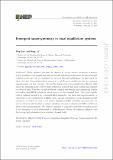Emergent supersymmetry in local equilibrium systems
Author(s)
Gao, Ping; Liu, Hong
Download13130_2018_Article_7406.pdf (765.0Kb)
PUBLISHER_CC
Publisher with Creative Commons License
Creative Commons Attribution
Terms of use
Metadata
Show full item recordAbstract
Many physical processes we observe in nature involve variations of macroscopic quantities over spatial and temporal scales much larger than microscopic molecular collision scales and can be considered as in local thermal equilibrium. In this paper we show that any classical statistical system in local thermal equilibrium has an emergent supersymmetry at low energies. We use the framework of non-equilibrium effective field theory for quantum many-body systems defined on a closed time path contour and consider its classical limit. Unitarity of time evolution requires introducing anti-commuting degrees of freedom and BRST symmetry which survive in the classical limit. The local equilibrium is realized through a Z2 dynamical KMS symmetry. We show that supersymmetry is equivalent to the combination of BRST and a specific consequence of the dynamical KMS symmetry, to which we refer as the special dynamical KMS condition. In particular, we prove a theorem stating that a system satisfying the special dynamical KMS condition is always supersymmetrizable. We discuss a number of examples explicitly, including model A for dynamical critical phenomena, a hydrodynamic theory of nonlinear diffusion, and fluctuating hydrodynamics for relativistic charged fluids.
Date issued
2018-01Department
Massachusetts Institute of Technology. Center for Theoretical Physics; Massachusetts Institute of Technology. Department of PhysicsJournal
Journal of High Energy Physics
Publisher
Springer International Publishing AG
Citation
Gao, Ping and Liu, Hong. "Emergent supersymmetry in local equilibrium systems." Journal of High Energy Physics 2018 (January 2018): 40 © 2018 The Author(s)
Version: Final published version
ISSN
1029-8479